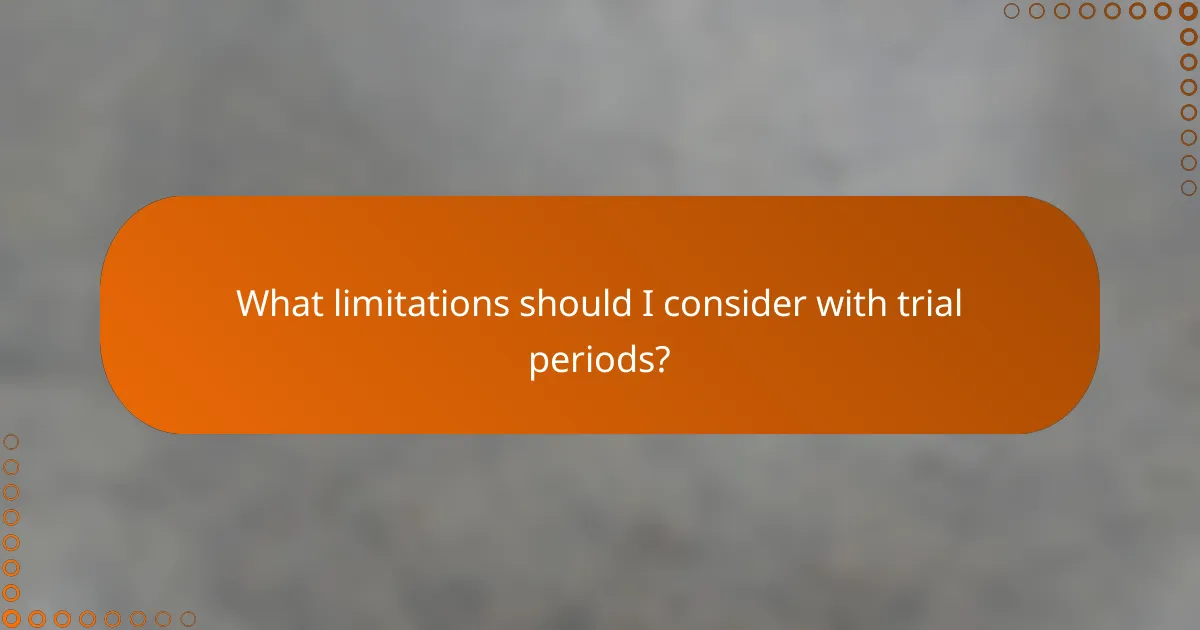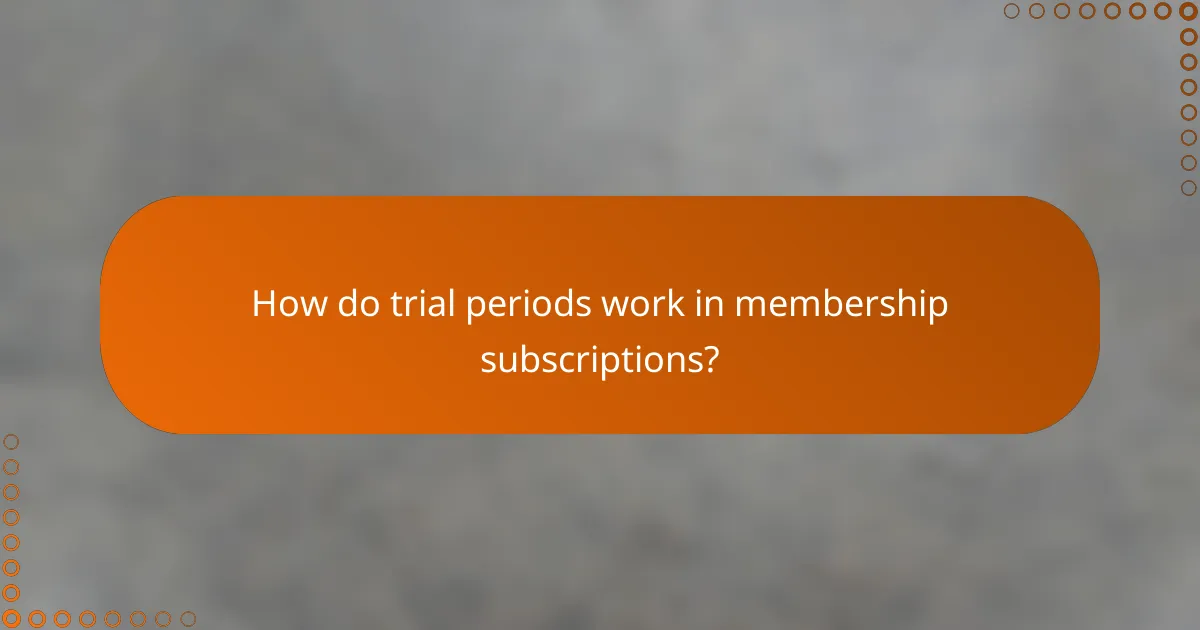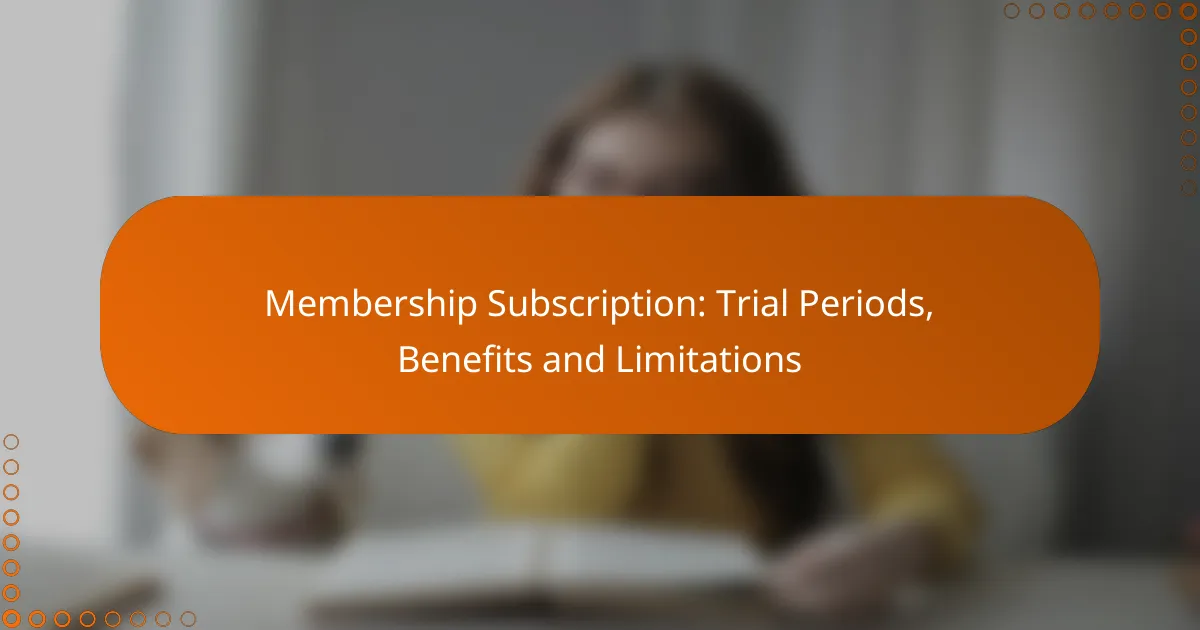Membership subscriptions provide users with exclusive access to content, cost savings, and enhanced community engagement. Trial periods allow potential members to experience these benefits at little to no cost, but they often come with limitations that may affect the overall experience. Understanding these aspects is crucial for making an informed decision before committing to a full subscription.

What are the benefits of membership subscriptions?
Membership subscriptions offer various advantages, including exclusive access to content, cost savings, and opportunities for community engagement. These benefits can enhance the overall experience and provide added value for subscribers.
Exclusive content access
Members often gain access to exclusive content that non-members cannot view. This may include premium articles, videos, or specialized resources tailored to specific interests.
For example, a streaming service might offer original series or films only available to subscribers, enhancing the value of the membership.
Cost savings on products
Membership subscriptions frequently provide discounts on products or services, allowing members to save money over time. These savings can range from a small percentage off regular prices to significant reductions during sales events.
For instance, a subscription to a beauty box service might offer members 20-30% off retail prices for featured products, making it financially beneficial.
Community engagement opportunities
Many memberships foster a sense of community among subscribers, offering forums, events, or social media groups for interaction. This engagement can lead to networking, collaboration, and shared experiences.
Participating in community events, such as webinars or meetups, can enhance the value of the membership by connecting members with like-minded individuals.
Personalized experiences
Membership subscriptions often include personalized experiences based on user preferences and behaviors. This can manifest as tailored recommendations, customized content feeds, or exclusive offers that align with individual interests.
For example, a fitness app might provide personalized workout plans or meal suggestions based on a member’s goals and activity levels, making the experience more relevant and effective.
Early access to new features
Subscribers may receive early access to new features or products before they are available to the general public. This can be particularly appealing for tech or gaming memberships, where staying ahead of trends is crucial.
For instance, a software subscription might allow members to test beta versions of new tools, providing valuable feedback while enjoying the latest advancements ahead of others.

What limitations should I consider with trial periods?
Trial periods often come with several limitations that users should be aware of before committing. These can affect how you experience the service and what you can do during the trial, potentially leading to unexpected charges or restrictions.
Time constraints on usage
Most trial periods are time-limited, typically ranging from a few days to a month. During this time, you may only have access to the service for a specified number of hours or sessions, which can restrict your ability to fully evaluate the offering.
For example, a streaming service might allow you to watch content for 30 days, but only during certain hours of the day. Be sure to check the specific time constraints before starting your trial.
Limited access to features
Trial versions often provide limited access to features compared to full subscriptions. This means you might miss out on premium functionalities that are essential for a complete experience.
For instance, a software application may restrict access to advanced tools or integrations, making it difficult to assess its full value. Always review what features are included in the trial to avoid surprises.
Automatic billing after trial
Many services automatically transition to a paid subscription once the trial period ends unless you cancel beforehand. This can lead to unexpected charges on your credit card if you’re not vigilant.
To avoid this, set a reminder a few days before the trial ends to decide whether to continue or cancel. Check the payment terms to understand the billing cycle and any potential fees involved.
Cancellation policies
Cancellation policies can vary significantly between services, impacting your ability to exit the trial without incurring charges. Some may allow cancellation at any time, while others might require notice a few days before the trial ends.
Review the cancellation terms carefully to ensure you understand how to opt-out if you choose not to continue. Document any necessary steps to make the process smoother and avoid confusion later on.

How do trial periods work in membership subscriptions?
Trial periods in membership subscriptions allow potential members to access services for free or at a reduced rate for a limited time. This enables users to evaluate the benefits before committing to a full subscription.
Duration of trial periods
Trial periods typically last from a few days to several weeks, depending on the service provider. Common durations include 7, 14, or 30 days, allowing users enough time to explore the offerings. Some platforms may even offer extended trials for promotional purposes.
Eligibility criteria for trials
Eligibility for trial periods often requires users to be new customers or to have not previously subscribed to the service. Some companies may also restrict trials to specific regions or demographic groups. Always check the terms and conditions to ensure you qualify before signing up.
Activation process for trials
Activating a trial period usually involves creating an account and providing payment information, even if the trial is free. Users should be aware that some services automatically convert to a paid subscription once the trial ends unless canceled beforehand. To avoid unexpected charges, set reminders to cancel if you decide not to continue.

What are the best practices for managing trial periods?
Managing trial periods effectively involves setting clear reminders, evaluating the service’s value, and understanding the associated terms and conditions. These practices help ensure that users make informed decisions about continuing their subscriptions after the trial ends.
Setting reminders for expiration
Setting reminders for the expiration of trial periods is crucial to avoid unexpected charges. Users should mark the end date on their calendars or set digital reminders a few days in advance to assess whether they want to continue the subscription.
Consider using apps or tools that can send notifications as the trial period nears its end. This proactive approach helps users avoid auto-renewal fees that can catch them off guard.
Evaluating value during trial
During the trial period, users should actively evaluate the value of the service. This includes assessing features, usability, and how well the service meets their needs compared to alternatives.
Creating a simple checklist can help in this evaluation. For example, users might consider factors like customer support quality, feature accessibility, and overall satisfaction. If the service does not meet expectations, it may be wise to cancel before the trial ends.
Understanding terms and conditions
Understanding the terms and conditions of a trial period is essential to avoid surprises. Users should read the fine print regarding cancellation policies, auto-renewal clauses, and any fees that may apply after the trial ends.
Many services offer a grace period for cancellation, but this varies widely. Familiarizing oneself with these details can prevent unwanted charges and ensure a smoother transition if the decision is made to discontinue the service.
